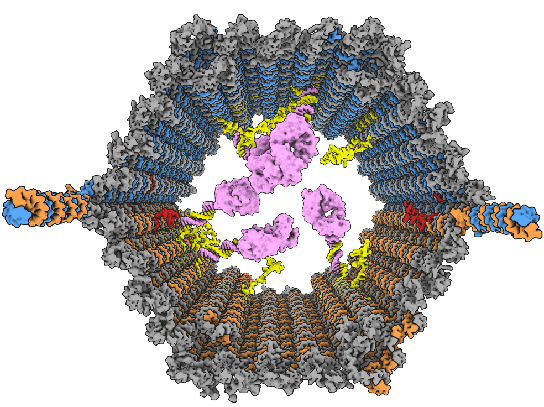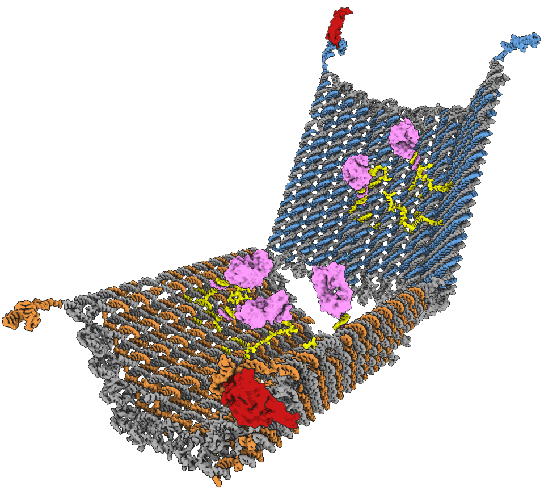Cancer-Fighting DNA Nanorobots Could Target Specific Cells for Repair
September 24, 2012

Wyss Institute scientists have developed a drug-delivering nanorobot that looks like an open-ended barrel (above). The exterior surface of the device is programmed to recognize a target on a cell surface; the drug payload (purple) is secured with anchor strands (yellow) to the interior. Double-stranded DNA latches (blue, red, and orange) ensure that the robot unlocks only in the presence of a molecular key expressed by the target cells. That opens the device (below right), enabling the payload to attack only the designated cells. Images courtesy of Shawn M. Douglas / Wyss Institute for Biologically Inspired Engineering
Nanites and nano-scale robots have been found mostly in the realm of science-fiction, but scientists at Harvard’s Wyss Institute for Biological Inspired Engineering are working on making them a reality. The goal is to track down and destroy a patient’s cancer cells, without having adverse effects on patients.
The scientists published their findings in the journal Science. Shawn Douglas, a research fellow at the Wyss Institute, describes a method for creating cellular robots, roughly the size of a virus, out of strands of protein and DNA. He’s dubbed the devices “DNA nanorobots,” and they are short, hexagonal tubes made of interwoven DNA that open along their length like a clamshell. At one end, there is a DNA hinge and at the other, there is a pair of twisted DNA fragments that act like latches to hold the device shut.

The inside can hold molecules of any substances, effectively turning it into a delivery device, transporting medication to specific cells inside the human body. The goal is to make tools that can target malfunctioning cells and fix them.
DNA is an ideal material for building devices at the nano-scale level. There are many developed tools in place to understand, manipulate and manufacture it. Using DNA synthesizers, it’s even possible to create custom lengths of molecules.
Scientists are using a process called DNA origami to assemble these tools. It was developed in 2006 at Caltech by a researcher named Paul Rothemund. First, a long strand of DNA is used as a backbone to scaffold the structure. The strand is mixed with short sequences of custom-built DNA that are designed to bind to specific sections of the scaffold, bending and twisting it into pre-determined shapes.
Douglas uses the DNA of the virus M13, harmless to humans, as a scaffold but any long DNA molecule will work. Each of the nanorobots measures 45 nanometers long by 35 nanometers in width, meaning that it can directly interact with the surface of individual cells.
The DNA nanorobots also track down specific cell types, thanks to their molecular latches. Aptimers, two twisted strands of DNA, can be designed to react to a specific chemical marker or ligand, on a particular cell type, like those in a cancerous tumor. Currently, Douglas is designing DNA aptimers that unravel in the presence of platelet-derived growth factor (PDGF), a protein which regulates cell growth and division. It’s over-expressed on the outer membrane of cancerous cells. This can be used as a target for the DNA nanorobots.
It’s hoped that by targeting specific cells in this fashion, the nanorobots will be able to treat diseases like cancer without the need for chemotherapy.
No comments:
Post a Comment